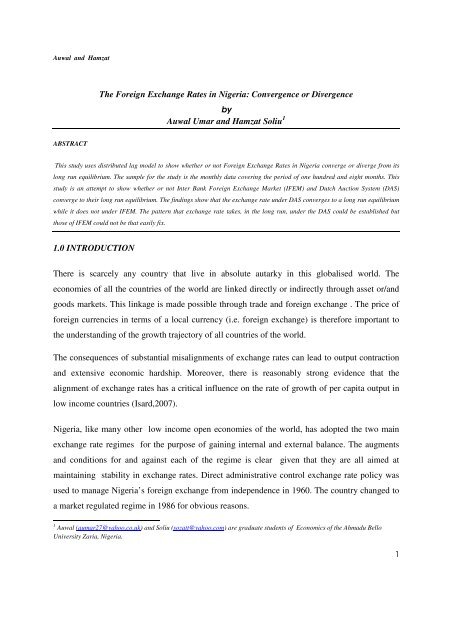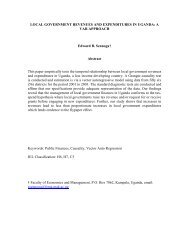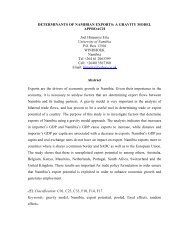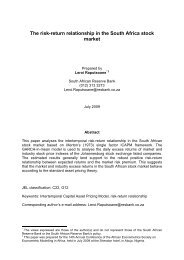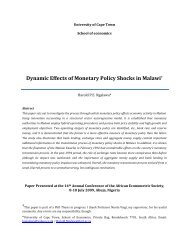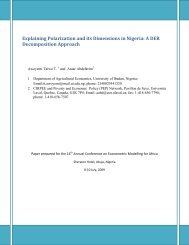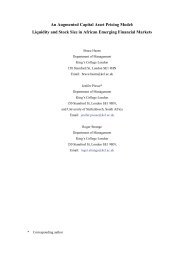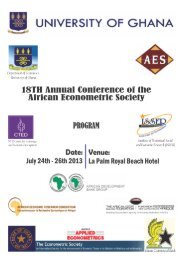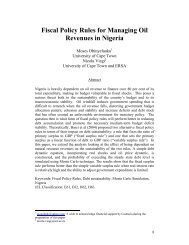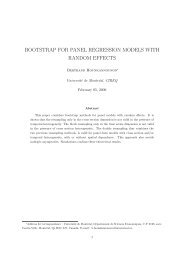The Foreign Exchange Rates in Nigeria - African Econometric Society
The Foreign Exchange Rates in Nigeria - African Econometric Society
The Foreign Exchange Rates in Nigeria - African Econometric Society
You also want an ePaper? Increase the reach of your titles
YUMPU automatically turns print PDFs into web optimized ePapers that Google loves.
Auwal and Hamzat<strong>The</strong> <strong>Foreign</strong> <strong>Exchange</strong> <strong>Rates</strong> <strong>in</strong> <strong>Nigeria</strong>: Convergence or DivergencebyAuwal Umar and Hamzat Soliu 1ABSTRACTThis study uses distributed lag model to show whether or not <strong>Foreign</strong> <strong>Exchange</strong> <strong>Rates</strong> <strong>in</strong> <strong>Nigeria</strong> converge or diverge from itslong run equilibrium. <strong>The</strong> sample for the study is the monthly data cover<strong>in</strong>g the period of one hundred and eight months. Thisstudy is an attempt to show whether or not Inter Bank <strong>Foreign</strong> <strong>Exchange</strong> Market (IFEM) and Dutch Auction System (DAS)converge to their long run equilibrium. <strong>The</strong> f<strong>in</strong>d<strong>in</strong>gs show that the exchange rate under DAS converges to a long run equilibriumwhile it does not under IFEM. <strong>The</strong> pattern that exchange rate takes, <strong>in</strong> the long run, under the DAS could be established butthose of IFEM could not be that easily fix.1.0 INTRODUCTION<strong>The</strong>re is scarcely any country that live <strong>in</strong> absolute autarky <strong>in</strong> this globalised world. <strong>The</strong>economies of all the countries of the world are l<strong>in</strong>ked directly or <strong>in</strong>directly through asset or/andgoods markets. This l<strong>in</strong>kage is made possible through trade and foreign exchange . <strong>The</strong> price offoreign currencies <strong>in</strong> terms of a local currency (i.e. foreign exchange) is therefore important tothe understand<strong>in</strong>g of the growth trajectory of all countries of the world.<strong>The</strong> consequences of substantial misalignments of exchange rates can lead to output contractionand extensive economic hardship. Moreover, there is reasonably strong evidence that thealignment of exchange rates has a critical <strong>in</strong>fluence on the rate of growth of per capita output <strong>in</strong>low <strong>in</strong>come countries (Isard,2007).<strong>Nigeria</strong>, like many other low <strong>in</strong>come open economies of the world, has adopted the two ma<strong>in</strong>exchange rate regimes for the purpose of ga<strong>in</strong><strong>in</strong>g <strong>in</strong>ternal and external balance. <strong>The</strong> augmentsand conditions for and aga<strong>in</strong>st each of the regime is clear given that they are all aimed atma<strong>in</strong>ta<strong>in</strong><strong>in</strong>g stability <strong>in</strong> exchange rates. Direct adm<strong>in</strong>istrative control exchange rate policy wasused to manage <strong>Nigeria</strong>’s foreign exchange from <strong>in</strong>dependence <strong>in</strong> 1960. <strong>The</strong> country changed toa market regulated regime <strong>in</strong> 1986 for obvious reasons.1 Auwal (aumar27@yahoo.co.uk) and Soliu (sozatt@yahoo.com) are graduate students of Economics of the Ahmadu BelloUniversity Zaria, <strong>Nigeria</strong>.1
Auwal and HamzatWhat is however yet to be clear is the relative advantage of the various organized marketarrangement for sell<strong>in</strong>g and buy<strong>in</strong>g the foreign exchange under the dirty float regime that thecountry now operates. <strong>The</strong> country has and is still experiment<strong>in</strong>g with various marketarrangements. First <strong>in</strong> 1986, it chose to operate the Second Tier <strong>Foreign</strong> <strong>Exchange</strong>Market(SFEM) on an auction basis. More than two decades now after the <strong>in</strong>troduction of theflexible exchange regime, <strong>Nigeria</strong> has operated several variants of the auction system (AuctionSystem, Dutch Auction System, Wholesale Dutch Auction System, Retail Dutch AuctionSystem) towards determ<strong>in</strong><strong>in</strong>g the exchange rate of the naira to US dollarThis work is different from Obaseki’s(1997)because his exam<strong>in</strong>ed the convergence of foreignexchange <strong>in</strong> the sense of unify<strong>in</strong>g all the foreign exchange rates(i.e parallel and official) <strong>in</strong>to as<strong>in</strong>gle realistic one. This study is <strong>in</strong>terested <strong>in</strong> relative advantage of the available allocationarrangement of foreign exchange.Specifically, this paper is written to show whether and how the different allocativearrangements of foreign exchange ensure that exchange rates converge towards a long runstability. Precisely, the paper is <strong>in</strong>terested <strong>in</strong> show<strong>in</strong>g whether and how the Retail Dutch AuctionSystem(RDAS) and Interbank <strong>Foreign</strong> <strong>Exchange</strong> Market would br<strong>in</strong>g about long run equilibrium<strong>in</strong> <strong>Nigeria</strong>’s foreign exchange rate.This research is important now more than ever because the naira is fac<strong>in</strong>g a lot of challenges asthe world faces f<strong>in</strong>ancial meltdown.This paper is divided <strong>in</strong>to five sections. Section two outl<strong>in</strong>es the development <strong>in</strong> <strong>Nigeria</strong>’sforeign exchange market and section three review received knowledges relevant to equilibriumexchange rate and auctions.<strong>The</strong> paper presents the methodology <strong>in</strong> section four. Section five isthe results and conclusions of the study.2.0 <strong>Exchange</strong> Rate Management <strong>in</strong> <strong>Nigeria</strong>Given the centrality of foreign exchange <strong>in</strong> <strong>in</strong>ternational economic transactions especially <strong>in</strong>develop<strong>in</strong>g country like <strong>Nigeria</strong>, the management of scarce foreign exchange has,over the years2
Auwal and Hamzatbeen a significant component of national economic management. Basically, there are two phasesto economic management <strong>in</strong> <strong>Nigeria</strong>.Dur<strong>in</strong>g the first phase (1970-1985), <strong>Nigeria</strong> operated a controlled exchange rate regime whereexchange rate of the naira was pegged to the dollar. <strong>The</strong> second phase of exchange rate history<strong>in</strong> <strong>Nigeria</strong> began <strong>in</strong> 1986.Follow<strong>in</strong>g the oil glut of early 80s, it became clear that <strong>Nigeria</strong>n economy which depend on oilwas not able to susta<strong>in</strong> the fixed exchange regime because its foreign reserves not onlydepleted but foreign debt also mounted . As an <strong>in</strong>tegral part of the Structural AdjustmentProgramme <strong>in</strong>troduced <strong>in</strong> 1986, the country adopted a flexible exchange rate through the Secondtier <strong>Foreign</strong> <strong>Exchange</strong> Market (SFEM).3.0 Received Knowledge.Discussions and analysis <strong>in</strong> this paper rest on the underly<strong>in</strong>g knowledge concern<strong>in</strong>g equilibriumexchange foreign rate on one hand and auction sales on the other. <strong>The</strong> aim is to trace theknowledge that expla<strong>in</strong>s realistic exchange rate <strong>in</strong> a market driven exchange rate. Auction is oneof the major allocative arrangement of foreign exchange <strong>in</strong> <strong>Nigeria</strong> <strong>in</strong> recent time.<strong>The</strong> sectionalso review empirical discussions relevant to the objective of this paper.Several methodologies have been used to characterize the equilibrium position of the exchangerate <strong>in</strong> the literature. While some of them are quite simplistic <strong>in</strong> nature others are conceptuallyquite complex. All of them, however, <strong>in</strong>volve some conceptual simplifications (Isard, 2007). Wesummarily adopt Isard's(2007) discussion of these approaches <strong>in</strong> this paper with fewmodifications to make it up to date.<strong>The</strong> various methodologies that can be used to expla<strong>in</strong> the equilibrium position of exchange ratecan be grouped <strong>in</strong>to six groups Isard(2007). <strong>The</strong> first and most simplistic is the Purchas<strong>in</strong>gPower Parity(PPP) approach. This approach is purely base on price .<strong>The</strong> theory underly<strong>in</strong>g thisapproach is that real exchange rates should rema<strong>in</strong> relatively constant over time, or that nom<strong>in</strong>alexchange rates should move <strong>in</strong> l<strong>in</strong>e with ratios of national price levels .Gustav Cassel <strong>in</strong> 19183
Auwal and Hamzatco<strong>in</strong>ed the term purchas<strong>in</strong>g power parity to describe such situation. <strong>The</strong> assumption underly<strong>in</strong>gthis approach is that free movement of merchandise would br<strong>in</strong>g about parity between thepurchas<strong>in</strong>g powers of the moneys of different countries, as <strong>in</strong>dicated by national price levels.<strong>The</strong> challenge aga<strong>in</strong>st this approach is how to decide on the choice of the price to be used tocompare ratios of currencies (Isard, 2007). A classic example of this is Churchill's overvaluationof the British pounds <strong>in</strong> 1925(by 12%) after the first world when he used wholesales price toestablish PPP <strong>in</strong>stead of retail price suggested by Keynes.Scholars have modified the PPP approach to take Balassa-Samuelson’s conjecture <strong>in</strong>toconsideration. <strong>The</strong> conjecture po<strong>in</strong>t to the fact that prices of nontradeable tend to <strong>in</strong>creaserelative to the prices of tradable with the growth of an economy. This is borne out of the believethat fast grow<strong>in</strong>g economies experience <strong>in</strong>creased productivity <strong>in</strong> tradable relative tonontradebles.<strong>The</strong> weak l<strong>in</strong>k, however, <strong>in</strong> the Balassa-Samuelson hypothesis, as applied to real exchange rates,is the assumption that the relative prices of tradable-goods across countries rema<strong>in</strong> relativelyconstant over time.<strong>The</strong> third major approach towards determ<strong>in</strong><strong>in</strong>g the equilibrium exchange rate is theMacroeconomic Balance (MB) framework approach. This approach sought an exchange rate thatguarantees <strong>in</strong>ternal and external balance of an economy. In apply<strong>in</strong>g the MB framework, it isuseful to def<strong>in</strong>e the concept of the underly<strong>in</strong>g current account position (UCUR) as the value ofcurrent account position (CUR)that would be observed at the prevail<strong>in</strong>g real exchange rate if allcountries were operat<strong>in</strong>g at full employment or potential output (<strong>in</strong>ternal balance) and if theeffects of past exchange rate changes had been completely realized. This is the appropriateconcept of the medium-run current account position associated with the prevail<strong>in</strong>g real exchangerate. A concept that adjusts for the bus<strong>in</strong>ess cycle(Isard, 2007)Recent advances <strong>in</strong> MB approach l<strong>in</strong>ks current account balance of an economy to the sav<strong>in</strong>g<strong>in</strong>vestmentgap to arrive at equilibrium exchange rate.4
Auwal and HamzatEquilibrium exchange rate could also be expla<strong>in</strong>ed through assessment of relativecompetitiveness of tradable goods. <strong>The</strong> rate of competitiveness of tradable goods will beassessed through some criteria at the prevail<strong>in</strong>g exchange change rate to determ<strong>in</strong>e whether ornot the rate is an equilibrium rate. Commonly-used <strong>in</strong>dicators of competitiveness <strong>in</strong>cludemeasures of profitability, trends <strong>in</strong> export volumes or shares of world exports, and trends <strong>in</strong>import penetration ratios.<strong>Exchange</strong> rates equations are other major approach often used <strong>in</strong> the literature to modelequilibrium exchange rate. Given some theoretical framework which l<strong>in</strong>ks equilibrium exchangerate to other variable, this approach estimate some reduced form equation derived from thetheoretical conceptions. Recent advance <strong>in</strong> econometrics has also made it possible the long runbehavior of exchange rate to be studied.F<strong>in</strong>ally, general equilibrium model is another approach to exchange rate model<strong>in</strong>g .It provides amore complete representation of macroeconomic behavior, it imposes important account<strong>in</strong>gidentities, and generate solutions (forecasts) for endogenous variables that are consistent withthose identities Soludo(1998).While several received knowledges have been offered to expla<strong>in</strong> equilibrium exchange rate,there are, however, few theories on auction market. Besides, empirical works on auctionsespecially as regard foreign exchange market is also few.Basically auctions could take one of the follow<strong>in</strong>g four types: ascend<strong>in</strong>g-bid auction (EnglishAuction), descend<strong>in</strong>g-bid auction (Dutch Auction), the first price sealed-bid and the second pricesealed-bid auctions. Also, objects of an auction could either be privately valued (like art works)or be a common value item (like currency).Vickrey’s(1961) work cited <strong>in</strong> Klemperer(2004) is the first formal attempt to recognize thegame-theoretic treatment of auctions. Through this work, he proposed some special cases of thenow most celebrated theory of auction sales (Revenue Equivalence <strong>The</strong>orem,) (Klemperer,2004).A more general form of Revenue Equivalence <strong>The</strong>orem (RET) assume that a number of riskneutralpotential buyers of an object has a privately known signal <strong>in</strong>dependently drawn from a5
Auwal and HamzatIf we know where the surplus function starts from i.e S i (vp ),itmechanisms and design have the same expected revenue.follows that all auctionFew empirical studies have attempted to validate theoretical models of auction <strong>in</strong> Sub-SaharanAfrica Aron and Elbadewi (1994b). Most empirical works only test the implication of the theorythrough the reduced-form model. For <strong>in</strong>stance , they try to expla<strong>in</strong> bids <strong>in</strong> term of a reserve price,the number of potential bidders, characteristics of the auctioned object which affect the commondistribution of private values (eg. Hasen 1985;Hendricks and Porter ,1988) .Adamgbe’s(2006)work on RDAS assume that Efficient Market Hypothesis(EMH) holds <strong>in</strong>the foreign exchange market .His works showed that RDAS has brought about relative stability<strong>in</strong> the exchange rate <strong>in</strong> the forex market <strong>in</strong> <strong>Nigeria</strong>. This work was <strong>in</strong>terested <strong>in</strong> a shortrunrelationship between exchange rate under RDAS and other variables. So the author used VAR tomodel exchange rate on <strong>in</strong>flation rate and lend<strong>in</strong>g rate. His conclusion can therefore not beapplicable to a long term period<strong>The</strong> important variables to the theoretical analysis of auction system are foreign exchangedemand, supply and opportunity cost (i.e parallel market rate). Empirical f<strong>in</strong>d<strong>in</strong>gs havecorroborated the suggestion of the theory of auction given these variables Aron and Elbadewi,1994a) cited <strong>in</strong> Auwal(2009). <strong>The</strong>ir f<strong>in</strong>d<strong>in</strong>gs show that <strong>in</strong>creased supply of foreign exchangebr<strong>in</strong>g about appreciation of local currency and <strong>in</strong>creased demand for foreign exchange causesdevaluation of local currency. Aron and Elbadewi (1994a) cited <strong>in</strong> Auwal(2009)also found that<strong>in</strong>creased number of bidders lead to equilibrium auction rate depreciation <strong>in</strong> <strong>Nigeria</strong>.4.0 Methodology4.1 Nature and Sources of Data.<strong>The</strong> data for this study are sourced from CBN’s website and its 2006 Statistical Bullet<strong>in</strong>. 2000 to2008 is the period covered. Inter Bank <strong>Foreign</strong> <strong>Exchange</strong> Market (IFEM) was operative between1999 to July 2002 <strong>in</strong> <strong>Nigeria</strong> and the Dutch Auction System was operative between 2000 to2008. <strong>The</strong> study therefore make use of both foreign exchange rates and quantity traded dur<strong>in</strong>gthese two allocation market arrangement.7
Auwal and Hamzat4.2Model Specification<strong>The</strong> study adopts an Autoregressive Distributed Lag(ARDL) model to expla<strong>in</strong> the long runrelationship between exchange rate and quantity of foreign exchange traded. This is partlybecause we subscribe to the conclusions of studies that have found out that Efficient MarketHypothesis is near reality <strong>in</strong> the foreign exchange market. Co<strong>in</strong>tegration could also be used forthe same purpose. <strong>The</strong> study uses ARDL because one do not need to worry about level of<strong>in</strong>tegration of the series .An ARDL model of exchange rate and quantity of exchange rate traded is therefore given asMRtft = 0,1,2,.... kMRtMRtMRtDDtDDtDDt= ( , ,...., , , ,...,− 1 −2−k−1− 2−k).......................(4)We reparameterised(4) <strong>in</strong> terms of levels and first difference to obta<strong>in</strong>∆MR+ ....= DD∆MR+t−kf ( , , , ,...., + + +t −1tt−1t−2t−kt−1t−1t−2µ t∆DD∆DD∆DD∆DDMR∆MR.....................................................................................................(5)∆MRfor DAS and∆IFEMRATE=+∆IFEMRf (t−2DD , ,t−1∆DDt∆DD∆IFEMR+t−k+ ....µ tt−1,∆DDt−2,....,∆DDt−kMRt−1................................................................(6)++∆IFEMRt−1for IFEMWhere MR, IFEMR and DD denotes marg<strong>in</strong>al rate of exchange, rate of exchange at the IFEMand demand respectively.8
Auwal and Hamzat<strong>The</strong> models specified <strong>in</strong> (4) is the longrun model of foreign exchange rate regardless of theallocation arrangement used to obta<strong>in</strong> the data. For the purpose of this study we used MRATEfor exchange rate under DAS and IFEMRATE under IFEM .5.0 Results and Conclusions<strong>The</strong> results of the test of a long run relation between exchange rate and the volume of foreignexchange dur<strong>in</strong>g the DAS regime show a significant relationship only when <strong>in</strong>formation onexchange rate <strong>in</strong> the three or previous days are taken <strong>in</strong>to consideration. This is shown <strong>in</strong> table 2<strong>in</strong> the appendix because the coefficient of the lagged dependent variable(MRATEt-1) issignificant at 7.6 %. Table three(<strong>in</strong> the appendix) shows the results of estimation of variables thatsignificantly impact on MRATE. It should be noted ,however, that the fit of the model (35%) isweak. When the differenced terms (<strong>in</strong> table three) are equated to zero, the long run relationbetween exchange rate (MR) and quantity traded (DD) is0.394767MR+t − 44127802 −0.399405DDt−1MR1=1.0117487DDt1= +t −1 −0 ................................(5)111781892 ..........................................................(6)From (6) , it is clear that the rate at which exchange rate under DAS moves towards its long runequilibrium is 1.0117.For IFEM, the results of estimation of the relationship between exchange rate and quantity tradedare shown <strong>in</strong> table for four and five of the Appendix below. <strong>The</strong>se results show long runrelationship between exchange rate and quantity traded does not exist <strong>in</strong> the long run as thecoefficient of the lagged dependent variable (IFEMRt-1) is not significant at 5% not even at 10%level of significance. Table four takes <strong>in</strong>formation about exchange rate <strong>in</strong> the two previous days<strong>in</strong>to consideration while table five takes those of three previous days <strong>in</strong>to consideration.<strong>The</strong> conclusion of the paper therefore is that while long run relationship exist when DAS is theallocative arrangement for foreign exchange market, it however does not exist when IFEM is theallocative arrangement for foreign exchange.9
Auwal and HamzatReferencesAdamgbe .E.T(2006) “<strong>Exchange</strong> Rate Management Under the Wholesale DAS <strong>in</strong><strong>Nigeria</strong>:Policy Implications”, West <strong>African</strong> Journal of Monetary and Economic IntergrationVol.6 No.1Aron J. and Elbadawi A b.(1994b)”<strong>Foreign</strong> exchange auction market <strong>in</strong> Sub-Saharan Africa:Dynamic Models for the Auction <strong>Exchange</strong> rate” <strong>The</strong> World Bank Policy Research Work<strong>in</strong>gPaper No.1395Auwal U(2009) “(G)ARCH and ARDL model of exchange rate: evidence from <strong>Nigeria</strong>”Economics Dept, Ahmadu Bello University Zaria, Ph.D class presentation (unpublished)Hansen R.(1985) “Empirical Test<strong>in</strong>g of Auction <strong>The</strong>ory” Economic Enquiry,24,125-142.Hendricks K and Porter R. (1988): “An Empirical Study of an Auction with AsymmetricInformation” <strong>The</strong> American Economic Review,78,865-883.Isard P. “Equilibrium <strong>Exchange</strong> <strong>Rates</strong>: Assessment Methodologies” IMF Work<strong>in</strong>g paperWP/07/296Klemperer.P(2004) Auctions: <strong>The</strong>ory and Practice . Oxford: Oxford University press,Nnana O.J (2002) “Towards <strong>Exchange</strong> Rate Stability <strong>in</strong> <strong>Nigeria</strong>” <strong>in</strong> Monetary Policy and<strong>Exchange</strong> Rate Stability, NES Proceed<strong>in</strong>gs of a One day Sem<strong>in</strong>ar Held on 23 May 2002 FederalPalace Hotel Lagos.ObasekiP.J(1997) “<strong>The</strong> Need for <strong>Exchange</strong> <strong>Rates</strong> Convergence <strong>in</strong> <strong>Nigeria</strong>” Central Bank of<strong>Nigeria</strong> Economic Review Vol35 No3.Obaseki P.J(2001) “Issues <strong>in</strong> <strong>Exchange</strong> Rate design and Management” Central Bank Economicand F<strong>in</strong>ancial Review Vol39 No.2Soludo C(1998) Macroeconomic Policy Modell<strong>in</strong>g of <strong>African</strong> Economies. Enugu:ACENAPublishers10
Auwal and HamzatVan’tdack J.(2001) “<strong>The</strong> Framework of Monetary Policy: An Overview of Issues” <strong>in</strong>proceed<strong>in</strong>gs :conference on Monetary policy frameworks <strong>in</strong> Africa, Reserve Bank of SouthAfrica Pretoria.AppendixTable 1.Dependent Variable: DMRMethod: Least SquaresDate: 06/08/09 Time: 20:25Sample(adjusted): 2002:11 2008:12Included observations: 74 after adjust<strong>in</strong>g endpo<strong>in</strong>tsWhite Heteroskedasticity-Consistent Standard Errors & CovarianceVariable Coefficient Std. Error t-Statistic Prob.C 26779004 17314888 1.546588 0.1267DEMAND(-1) -0.221526 0.181264 -1.222117 0.2260D(DEMAND) -0.333463 0.079391 -4.200243 0.0001D(DEMAND(-1)) -0.426455 0.152251 -2.800996 0.0067D(DEMAND(-2)) -0.035372 0.182209 -0.194130 0.8467MRATE(-1) -0.204774 0.202225 -1.012607 0.3149D(MRATE(-1)) -0.250556 0.360340 -0.695331 0.4893D(MRATE(-2)) -0.443697 0.166692 -2.661783 0.0098R-squared 0.330575 Mean dependent var 2117115.Adjusted R-squared 0.259575 S.D. dependent var 64071554S.E. of regression 55132244 Akaike <strong>in</strong>fo criterion 38.59017Sum squared resid 2.01E+17 Schwarz criterion 38.83926Log likelihood -1419.836 F-statistic 4.656012Durb<strong>in</strong>-Watson stat 1.903040 Prob(F-statistic) 0.000277Table 2Dependent Variable: D(MR)Method: Least SquaresDate: 06/08/09 Time: 20:29Sample(adjusted): 2002:12 2008:12Included observations: 73 after adjust<strong>in</strong>g endpo<strong>in</strong>tsWhite Heteroskedasticity-Consistent Standard Errors & CovarianceVariable Coefficient Std. Error t-Statistic Prob.C 36611371 17575230 2.083123 0.0413DEMAND(-1) -0.321338 0.182601 -1.759784 0.0833D(DEMAND) -0.339278 0.080434 -4.218090 0.0001D(DEMAND(-1)) -0.331003 0.154317 -2.144955 0.0358D(DEMAND(-2)) 0.060917 0.176354 0.345423 0.7309D(DEMAND(-3)) 0.098632 0.240031 0.410911 0.6825MRATE(-1) -0.316687 0.175697 -1.802465 0.076311
Auwal and HamzatD(MRATE(-1)) -0.102631 0.308354 -0.332837 0.7404D(MRATE(-2)) -0.266151 0.157071 -1.694460 0.0951D(MRATE(-3)) 0.343175 0.227731 1.506936 0.1368R-squared 0.355118 Mean dependent var 2146117.Adjusted R-squared 0.262992 S.D. dependent var 64514472S.E. of regression 55385130 Akaike <strong>in</strong>fo criterion 38.62417Sum squared resid 1.93E+17 Schwarz criterion 38.93793Log likelihood -1399.782 F-statistic 3.854703Durb<strong>in</strong>-Watson stat 2.008282 Prob(F-statistic) 0.000624Table 3.Dependent Variable: D(MRATE)Method: Least SquaresDate: 06/08/09 Time: 20:33Sample(adjusted): 2002:11 2008:12Included observations: 74 after adjust<strong>in</strong>g endpo<strong>in</strong>tsWhite Heteroskedasticity-Consistent Standard Errors & CovarianceVariable Coefficient Std. Error t-Statistic Prob.C 44127802 22181404 1.989405 0.0507DEMAND(-1) -0.399405 0.223176 -1.789644 0.0780D(DEMAND) -0.402412 0.110587 -3.638863 0.0005D(DEMAND(-1)) -0.257385 0.138872 -1.853400 0.0682MRATE(-1) -0.394767 0.169838 -2.324368 0.0231D(MRATE(-2)) -0.291808 0.142638 -2.045789 0.0446R-squared 0.316015 Mean dependent var 2117115.Adjusted R-squared 0.265722 S.D. dependent var 64071554S.E. of regression 54902921 Akaike <strong>in</strong>fo criterion 38.55764Sum squared resid 2.05E+17 Schwarz criterion 38.74445Log likelihood -1420.633 F-statistic 6.283483Durb<strong>in</strong>-Watson stat 2.018791 Prob(F-statistic) 0.000075Table 4.Dependent Variable: D(IFEMRATE)Method: Least SquaresDate: 06/08/09 Time: 21:02Sample(adjusted): 2000:04 2002:06Included observations: 27 after adjust<strong>in</strong>g endpo<strong>in</strong>tsWhite Heteroskedasticity-Consistent Standard Errors & CovarianceVariable Coefficient Std. Error t-Statistic Prob.C 26.83544 15.92336 1.685288 0.1083D(DEMAND) 6.85E-06 5.88E-06 1.164884 0.2585DEMAND(-1) 1.30E-05 1.07E-05 1.206947 0.2423D(DEMAND(-1)) -9.77E-06 9.57E-06 -1.021062 0.3201D(DEMAND(-2)) -9.51E-06 1.07E-05 -0.887255 0.3860IFEMRATE(-1) -0.324476 0.201664 -1.608993 0.1241D(IFEMRATE(-1)) -0.207909 0.264473 -0.786125 0.4415D(IFEMRATE(-2)) 0.064834 0.257866 0.251424 0.804212
Auwal and HamzatR-squared 0.427819 Mean dependent var 0.661111Adjusted R-squared 0.217016 S.D. dependent var 4.569053S.E. of regression 4.042990 Akaike <strong>in</strong>fo criterion 5.873041Sum squared resid 310.5696 Schwarz criterion 6.256993Log likelihood -71.28605 F-statistic 2.029469Durb<strong>in</strong>-Watson stat 1.907970 Prob(F-statistic) 0.104237Table 5.Dependent Variable: D(IFEMRATE)Method: Least SquaresDate: 06/08/09 Time: 21:09Sample(adjusted): 2000:05 2002:06Included observations: 26 after adjust<strong>in</strong>g endpo<strong>in</strong>tsWhite Heteroskedasticity-Consistent Standard Errors & CovarianceVariable Coefficient Std. Error t-Statistic Prob.C 23.70088 17.98225 1.318015 0.2061DEMAND(-1) 1.31E-05 1.30E-05 1.011786 0.3267D(DEMAND) 8.96E-06 1.07E-05 0.834336 0.4164D(DEMAND(-1)) -7.19E-06 9.52E-06 -0.755075 0.4612D(DEMAND(-2)) -7.11E-06 9.91E-06 -0.716853 0.4838D(DEMAND(-3)) 1.37E-06 4.67E-06 0.293032 0.7733IFEMRATE(-1) -0.298319 0.214914 -1.388087 0.1841D(IFEMRATE(-1)) -0.201226 0.302589 -0.665015 0.5155D(IFEMRATE(-2)) 0.102530 0.367486 0.279004 0.7838D(IFEMRATE(-3)) 0.073547 0.325619 0.225869 0.8242R-squared 0.431033 Mean dependent var 0.696154Adjusted R-squared 0.110989 S.D. dependent var 4.655836S.E. of regression 4.389865 Akaike <strong>in</strong>fo criterion 6.080197Sum squared resid 308.3347 Schwarz criterion 6.564080Log likelihood -69.04256 F-statistic 1.346794Durb<strong>in</strong>-Watson stat 1.888569 Prob(F-statistic) 0.28891113


